Lev Russov
| Lev Alexandrovich Russov | |
|---|---|
 | |
| Born |
January 31, 1926 Leningrad, Soviet Union |
| Died |
February 20, 1987 Leningrad, Soviet Union |
| Nationality | Russian |
| Education | Tavricheskaya Art School, Repin Institute of Arts |
| Known for | Painting, Graphics, Sculpture |
| Movement | Realism |
Lev Alexandrovich Russov (Russian: Ле́в Алекса́ндрович Ру́сов; January 31, 1926 – February 20, 1987) was a Soviet Russian painter, graphic artist, and sculptor, living and working in Leningrad. A member of the Leningrad Union of Artists,[1] he was regarded as one of the leading representatives of the Leningrad school of painting,[2] being most famous for his portraits.
Biography
Lev Alexandrovich Russov was born January 31, 1926, in Leningrad. In 1939-1941 he studied at the Art studio of the Wyborg district of Leningrad. In December 1941, along with his mother he was evacuated from the siege of Leningrad in the Gorky region. In 1943, for continuing art education he moved to Kostroma city, where goes to the regional art school. In 1945, in connection with the return to Leningrad Russov was transferred to Tavricheskaya Art School, from which he graduated in 1947.[3]

After graduation Russov entered the first course of Painting Department of Institute of Painting, Sculpture and Architecture namen after Ilya Repin, studied of Yuri Neprintsev and Genrikh Pavlovsky. However, having studied for two years for health reasons had to leave class. In 1951–1955 Russov taught drawing in the secondary schools of Leningrad, while continuing to worked on his painting skills.
Since the mid-1950s, Russov participates in exhibitions of Leningrad artists. At the Spring exhibitions of 1954 and 1955, Russov shows paintings "A Girl with a Bow"[4] (1954), "At the Sea" and "Portrait of Artist Vladimir Kremer"[5] (both 1955), immediately attracting attention as talented painter.
In 1955, for his portrait paintings, Lev Russov was admitted to the Leningrad Union of Artists on the recommendation of renowned artists Piotr Buchkin, Yuri Neprintsev, and Veniamin Kremer. He painted portraits, genre and historical paintings, still lifes, landscapes, worked in watercolors and woodcuts.
In the years 1954-1956 Lev Russov was drawn to the historical genre, creating a series of eight paintings on the novel by Charles de Coster's "The Legend of Thyl Ulenspiegel". Choosing a theme and its figurative embodiment echoed the mood of the Khrushchev "Thaw" and personal freedom-loving aspirations of the author. Shown at the end of 1956 at the Autumn exhibition of Leningrad artists works "A Birth", "On Tortures", "A Death of father", "On the Fields of the Motherland", "A Boarding (Insurgent Flandria)", "Till and Lamme", "Death to traitors", "Song of Till" (all 1956), first brought the author fame and claimed him as a master of historical painting.[6]
These works, and above all the double portrait of "Till and Lamme", are also interesting in that the artist gave Thill features a close resemblance to the author. This makes it unique in the creative legacy of the artist as self-portraits of Lev Russov are unknown. As a child he lost one eye and did not like to be photographed and a general refusal to pose for portraits, painted by himself or others.
Year of 1955 was awarded to Lev Russov meet peoples, which had a major influence on his subsequent artistic and personal life. At first he met with Catherine Balebina (born December 29, 1933), daughter of Vasily Balebin, the famed military pilot and torpedo-bomber, the Hero of the Soviet Union and Great Patriotic War. Soon she became his wife (the marriage will be officially registered on 31 January 1959), the mother of his son (Andrew Russov was born April 27, 1960) and his principal muse. Charming, lively and full of determination, she posed for Leo Russov as a model for many paintings and portraits. For many years, their partnership created and preserved a world which manifested itself in full force and maximized Russov's artistic talents.
In the same year was born longstanding friendship between Lev Russov and Yevgeny Mravinsky, thanks which we have a few perfect portraits of eminent conductor, created in 1950-1980s.
With the greatest strength pictorial talent Lev Russov revealed in a series of portraits of contemporaries, established in mid-1950s - the first half of the 1960s. Among them are "Portrait of Natali Orlova"[7] (1956), "Portrait of Catherine Balebina"[8] (1956), "Zoya"[9] (1957), "Portrait of conductor Yevgeny Mravinsky"[10] (1957), "Natasha"(1958), "Portrait of an actor Vladislav Strzhelchik"[11] (1957), "Kira and Zoya"[12] (1958), "Young Caster"[13] (1961), "Kira"[14] (1962), "Portrait of a Son" (1965), and others.
The works of this period are in the time of the Lev Russov highest artistic peak as painter and constitute the most valuable part of his diverse artistic heritage. They are distinguished by an extraordinary expressive images, daring compositional decisions, unmistakable artistic taste. The color palette is dominated by pearl and purple hues.
Creative manner of the artist featured a powerful pictorial language, a broad style of painting, sharp composition, interest in the unusual angles. Lev Russov possessing a rare ability to catch the fleeting state of nature quickly put into a canvas picturesque idea - immediately and extremely convincing. He created the images combine the expressiveness of the individual characteristics of a vivid reflection of the typical features of contemporaries.

In his portraits Lev Russov can catch a direct state of nature, which, if prolonged posturing elude the majority of artists. This first impression he knows how to keep to the end and to convey to the viewer. Therefore, the nature of his works live, and this feeling of living eyes of living people - perhaps the most exciting in the works of the artist.
Along with the expressive form of portraits of Lev Russov different depth and psychological images, careful selection and study of nature. This was another important reason for the success of his works. Many of the best works of this period Lev Russov painted in a Pavshino village on the Oredezh river near Leningrad, where in late 1950 settled a group of young artists.
In mid-1960s Lev Russov enjoys wooden sculpture and Russian folk epic. From now until the end of life it becomes the main theme of his work, surpassing the painting. From his hands came out a lot of superb sculptures, from small figurines to large forms, such as "Russian Icarus" and the relief on the epic theme of "Zastava", "Folk singers". In 1970 in Leningrad Physico-Technical Institute named after Ioffe of the Academy of Sciences of the USSR was held a single lifetime exhibition of works by Lev Russov.
Lev Alexandrovich Russov died in Leningrad on February 20, 1987 at the sixty-second year of life from heart disease. His paintings reside in Art Museums and private collections in Russia, Norway, China, Great Britain, Sweden, in the U.S., France, and other countries. Artist's widow Catherine Balebina survived her husband for 15 years and died June 20, 2002 in Saint Petersburg at the sixty-ninth year of life.
See also
- Portrait of Catherine Balebina
- Portrait of Yevgeny Mravinsky
- Fine Art of Leningrad
- Leningrad School of Painting
- Leningrad School of Painting
- List of Russian artists
- List of 20th-century Russian painters
- List of painters of Saint Petersburg Union of Artists
- Saint Petersburg Union of Artists
References
- ↑ Directory of Members of the Union of Artists of USSR. Volume 2. Moscow, Soviet artist, 1979. P.290.
- ↑ Sergei V. Ivanov. Unknown Socialist Realism. The Leningrad School. Saint Petersburg, NP-Print Edition, 2007. P.12, 15, 24, 28, 368, 414-416, 420, 422-423.
- ↑ Sergei V. Ivanov. Unknown Socialist Realism. The Leningrad School. Saint Petersburg, NP-Print Edition, 2007. P.368
- ↑ The Spring Exhibition of works by Leningrad artists of 1954. Exhibition Catalogue. Leningrad, Leningrad Union of Artists, 1954. P.17.
- ↑ The Spring Exhibition of works by Leningrad artists of 1955. Catalogue. Leningrad, Leningrad Union of Artists, 1956. P.16.
- ↑ The Fall Exhibition of works by Leningrad artists of 1956. Exhibition Catalogue. Leningrad, The Leningrad Artist, 1958. P.21.
- ↑ Sergei V. Ivanov. Unknown Socialist Realism. The Leningrad School. Saint Petersburg, NP-Print Edition, 2007. P.151.
- ↑ Sergei V. Ivanov. Unknown Socialist Realism. The Leningrad School. Saint Petersburg, NP-Print Edition, 2007. P.65.
- ↑ Sergei V. Ivanov. Unknown Socialist Realism. The Leningrad School. Saint Petersburg, NP-Print Edition, 2007. P.35.
- ↑ 1917 - 1957. Exhibition of works by Leningrad artists of 1957. Exhibition Catalogue. Leningrad, Khudozhnik RSFSR, 1958. P.28.
- ↑ 1917 - 1957. Exhibition of works by Leningrad artists of 1957. Exhibition Catalogue. Leningrad, Khudozhnik RSFSR, 1958. P.28.
- ↑ Sergei V. Ivanov. Unknown Socialist Realism. The Leningrad School. Saint Petersburg, NP-Print Edition, 2007. P.49.
- ↑ Exhibition of works by Leningrad artists of 1961. Exhibition catalogue. Leningrad, Khudozhnik RSFSR, 1964. P.34.
- ↑ Sergei V. Ivanov. Unknown Socialist Realism. The Leningrad School. Saint Petersburg, NP-Print Edition, 2007. P.142.
Gallery
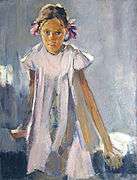 Little Bows. 1960
Little Bows. 1960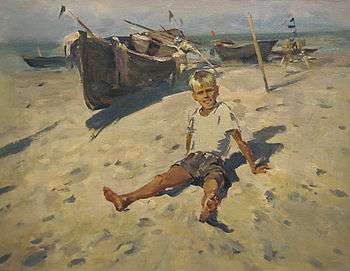 A Boy and Sea. 1955
A Boy and Sea. 1955 Portrait of E. Balebina. 1956
Portrait of E. Balebina. 1956 Portrait of Son. 1965
Portrait of Son. 1965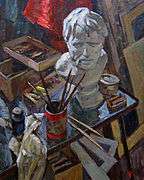 Still life with Seneca. 1963
Still life with Seneca. 1963 Indian Girl. 1957
Indian Girl. 1957 A Men in Red Shirt. 1973
A Men in Red Shirt. 1973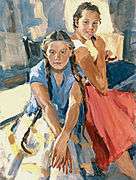 Kira and Zoya. 1958
Kira and Zoya. 1958 Zoya. 1957
Zoya. 1957 A Birth. 1956
A Birth. 1956 Song of Till. 1956
Song of Till. 1956 Till and Lamme. 1956
Till and Lamme. 1956 Insurgent Flandria. 1956
Insurgent Flandria. 1956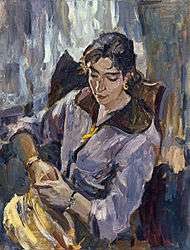 Portrait of Natali Orlova. 1956
Portrait of Natali Orlova. 1956 The Leningrad Symphony, conducted by Yevgeny Mravinsky. 1980
The Leningrad Symphony, conducted by Yevgeny Mravinsky. 1980
Principal Exhibitions
- 1954 (Leningrad): The Spring Exhibition of works by Leningrad artists of 1954, with Evgenia Antipova, Nikolai Baskakov, Leonid Baykov, Dmitry Belyaev, Dmitry Buchkin, Leonid Baykov, Sergei Frolov, Nikolai Galakhov, Vladimir Gorb, Maya Kopitseva, Boris Korneev, Elena Kostenko, Anna Kostrova, Gevork Kotiantz, Valeria Larina, Boris Lavrenko, Ivan Lavsky, Gavriil Malish, Alexei Mozhaev, Nikolai Mukho, Samuil Nevelshtein, Yuri Neprintsev, Sergei Osipov, Lev Russov, Ivan Savenko, Vladimir Seleznev, Arseny Semionov, Alexander Shmidt, Elena Skuin, Victor Teterin, Nikolai Timkov, Mikhail Tkachev, Leonid Tkachenko, Vecheslav Zagonek, and other important Leningrad artists.
- 1955 (Leningrad): The Spring Exhibition of works by Leningrad artists of 1955, with Evgenia Antipova, Irina Baldina, Leonid Baykov, Dmitry Buchkin, Vladimir Gorb, Alexei Eriomin, Maya Kopitseva, Gevork Kotiantz, Boris Lavrenko, Ivan Lavsky, Dmitry Maevsky, Gavriil Malish, Nikolai Mukho, Lev Orekhov, Sergei Osipov, Filaret Pakun, Genrikh Pavlovsky, Varlen Pen, Lev Russov, Ivan Savenko, Arseny Semionov, Alexander Semionov, Yuri Shablikin, Alexander Shmidt, Elena Skuin, Nikolai Timkov, Leonid Tkachenko, Yuri Tulin, Boris Ugarov, Piotr Vasiliev, Vecheslav Zagonek, Ruben Zakharian, Elena Zhukova, and other important Leningrad artists.
- 1956 (Leningrad): The Fall Exhibition of works by Leningrad artists of 1956, with Piotr Alberti, Taisia Afonina, Vsevolod Bazhenov, Irina Baldina, Nikolai Baskakov, Yuri Belov, Piotr Belousov, Piotr Buchkin, Sergei Frolov, Nikolai Galakhov, Vladimir Gorb, Abram Grushko, Alexei Eriomin, Mikhail Kaneev, Marina Kozlovskaya, Tatiana Kopnina, Maya Kopitseva, Boris Korneev, Alexander Koroviakov, Elena Kostenko, Nikolai Kostrov, Anna Kostrova, Gevork Kotiantz, Yaroslav Krestovsky, Ivan Lavsky, Oleg Lomakin, Dmitry Maevsky, Gavriil Malish, Alexei Mozhaev, Nikolai Mukho, Samuil Nevelshtein, Sergei Osipov, Vladimir Ovchinnikov, Lev Russov, Ivan Savenko, Gleb Savinov, Vladimir Seleznev, Alexander Semionov, Arseny Semionov, Yuri Shablikin, Boris Shamanov, Alexander Shmidt, Nadezhda Shteinmiller, Victor Teterin, Nikolai Timkov, Mikhail Tkachev, Mikhail Trufanov, Yuri Tulin, Piotr Vasiliev, Igor Veselkin, Rostislav Vovkushevsky, Vecheslav Zagonek, Ruben Zakharian, Sergei Zakharov, and other important Leningrad artists.
- 1957 (Leningrad): 1917 - 1957. Leningrad Artist's works of Art Exhibition, with Evgenia Antipova, Vsevolod Bazhenov, Irina Baldina, Nikolai Baskakov, Piotr Belousov, Piotr Buchkin, Zlata Bizova, Vladimir Chekalov, Sergei Frolov, Nikolai Galakhov, Abram Grushko, Alexei Eriomin, Mikhail Kaneev, Engels Kozlov, Tatiana Kopnina, Maya Kopitseva, Boris Korneev, Alexander Koroviakov, Nikolai Kostrov, Anna Kostrova, Gevork Kotiantz, Yaroslav Krestovsky, Boris Lavrenko, Ivan Lavsky, Oleg Lomakin, Dmitry Maevsky, Gavriil Malish, Alexei Mozhaev, Evsey Moiseenko, Nikolai Mukho, Mikhail Natarevich, Samuil Nevelshtein, Dmitry Oboznenko, Lev Orekhov, Sergei Osipov, Vladimir Ovchinnikov, Nikolai Pozdneev, Alexander Pushnin, Lev Russov, Galina Rumiantseva, Ivan Savenko, Gleb Savinov, Alexander Samokhvalov, Arseny Semionov, Alexander Mikhailovich Semionov, Boris Shamanov, Alexander Shmidt, Nadezhda Shteinmiller, Galina Smirnova, Ivan Sorokin, Victor Teterin, Mikhail Tkachev, Leonid Tkachenko, Yuri Tulin, Ivan Varichev, Nina Veselova, Rostislav Vovkushevsky, Anatoli Vasiliev, Lazar Yazgur, Vecheslav Zagonek, Ruben Zakharian, Sergei Zakharov, Maria Zubreeva, and other important Leningrad artists.
- 1958 (Leningrad): The Fall Exhibition of works by Leningrad artists of 1958, with Taisia Afonina, Irina Baldina, Evgenia Baykova, Vsevolod Bazhenov, Piotr Belousov, Yuri Belov, Zlata Bizova, Sergei Frolov, Nikolai Galakhov, Elena Gorokhova, Abram Grushko, Alexei Eriomin, Mikhail Kaneev, Marina Kozlovskaya, Tatiana Kopnina, Boris Korneev, Alexander Koroviakov, Elena Kostenko, Nikolai Kostrov, Anna Kostrova, Gevork Kotiantz, Yaroslav Krestovsky, Valeria Larina, Boris Lavrenko, Ivan Lavsky, Piotr Litvinsky, Oleg Lomakin, Dmitry Maevsky, Gavriil Malish, Alexei Mozhaev, Evsey Moiseenko, Nikolai Mukho, Anatoli Nenartovich, Yuri Neprintsev, Dmitry Oboznenko, Sergei Osipov, Vladimir Ovchinnikov, Nikolai Pozdneev, Alexander Pushnin, Maria Rudnitskaya, Galina Rumiantseva, Lev Russov, Ivan Savenko, Gleb Savinov, Alexander Samokhvalov, Arseny Semionov, Alexander Semionov, Yuri Shablikin, Boris Shamanov, Alexander Shmidt, Nadezhda Shteinmiller, Elena Skuin, Nikolai Timkov, Yuri Tulin, Ivan Varichev, Anatoli Vasiliev, Piotr Vasiliev, Igor Veselkin, Vecheslav Zagonek, and other important Leningrad artists.
- 1960 (Leningrad): Exhibition of works by Leningrad artists of 1960, with Piotr Alberti, Evgenia Antipova, Taisia Afonina, Genrikh Bagrov, Vsevolod Bazhenov, Irina Baldina, Nikolai Baskakov, Yuri Belov, Piotr Belousov, Piotr Buchkin, Zlata Bizova, Vladimir Chekalov, Sergei Frolov, Nikolai Galakhov, Vladimir Gorb, Elena Gorokhova, Abram Grushko, Alexei Eriomin, Mikhail Kaneev, Engels Kozlov, Marina Kozlovskaya, Tatiana Kopnina, Maya Kopitseva, Boris Korneev, Alexander Koroviakov, Elena Kostenko, Nikolai Kostrov, Anna Kostrova, Gevork Kotiantz, Vladimir Krantz, Yaroslav Krestovsky, Valeria Larina, Boris Lavrenko, Ivan Lavsky, Piotr Litvinsky, Oleg Lomakin, Dmitry Maevsky, Gavriil Malish, Nikita Medovikov, Evsey Moiseenko, Nikolai Mukho, Andrey Milnikov, Vera Nazina, Mikhail Natarevich, Anatoli Nenartovich, Samuil Nevelshtein, Dmitry Oboznenko, Vladimir Ovchinnikov, Vecheslav Ovchinnikov, Sergei Osipov, Nikolai Pozdneev, Alexander Pushnin, Lev Russov, Galina Rumiantseva, Maria Rudnitskaya, Ivan Savenko, Vladimir Sakson, Gleb Savinov, Alexander Samokhvalov, Alexander Semionov, Arseny Semionov, Yuri Shablikin, Boris Shamanov, Alexander Shmidt, Nadezhda Shteinmiller, Elena Skuin, Galina Smirnova, Alexander Sokolov, Alexander Stolbov, Victor Teterin, Nikolai Timkov, Mikhail Tkachev, Leonid Tkachenko, Mikhail Trufanov, Yuri Tulin, Ivan Varichev, Anatoli Vasiliev, Valery Vatenin, Nina Veselova, Rostislav Vovkushevsky, Vecheslav Zagonek, Sergei Zakharov, Ruben Zakharian, and other important Leningrad artists.
- 1961 (Leningrad): Exhibition of works by Leningrad artists of 1961, with Piotr Alberti, Evgenia Antipova, Taisia Afonina, Vsevolod Bazhenov, Irina Baldina, Nikolai Baskakov, Yuri Belov, Piotr Belousov, Piotr Buchkin, Zlata Bizova, Nikolai Galakhov, Elena Gorokhova, Abram Grushko, Alexei Eriomin, Mikhail Kaneev, Mikhail Kozell, Engels Kozlov, Marina Kozlovskaya, Maya Kopitseva, Boris Korneev, Elena Kostenko, Anna Kostrova, Gevork Kotiantz, Yaroslav Krestovsky, Valeria Larina, Boris Lavrenko, Ivan Lavsky, Oleg Lomakin, Dmitry Maevsky, Gavriil Malish, Nikita Medovikov, Evsey Moiseenko, Alexei Mozhaev, Nikolai Mukho, Vera Nazina, Mikhail Natarevich, Anatoli Nenartovich, Samuil Nevelshtein, Yuri Neprintsev, Dmitry Oboznenko, Sergei Osipov, Vladimir Ovchinnikov, Nikolai Pozdneev, Alexander Pushnin, Galina Rumiantseva, Lev Russov, Maria Rudnitskaya, Ivan Savenko, Gleb Savinov, Vladimir Sakson, Alexander Samokhvalov, Vladimir Seleznev, Arseny Semionov, Alexander Semionov, Yuri Shablikin, Boris Shamanov, Alexander Shmidt, Nadezhda Shteinmiller, Elena Skuin, Smirnova Galina, Alexander Sokolov, Alexander Stolbov, Victor Teterin, Nikolai Timkov, Leonid Tkachenko, Mikhail Trufanov, Yuri Tulin, Ivan Varichev, Anatoli Vasiliev, Piotr Vasiliev, Valery Vatenin, Lazar Yazgur, Vecheslav Zagonek, Sergei Zakharov, Maria Zubreeva, and other important Leningrad artists.
- 1980 (Leningrad): Regional Exhibition of works by Leningrad artists of 1980, with Evgenia Antipova, Taisia Afonina, Vsevolod Bazhenov, Irina Baldina, Nikolai Baskakov, Piotr Belousov, Dmitry Belyaev, Olga Bogaevskaya, Veniamin Borisov, Zlata Bizova, Lev Chegorovsky, Nikolai Galakhov, Vasily Golubev, Elena Gorokhova, Abram Grushko, Irina Dobrekova, German Egoshin, Alexei Eriomin, Mikhail Kaneev, Yuri Khukhrov, Mikhail Kozell, Marina Kozlovskaya, Engels Kozlov, Maya Kopitseva, Boris Korneev, Victor Korovin, Elena Kostenko, Nikolai Kostrov, Anna Kostrova, Gevork Kotiantz, Vladimir Krantz, Yaroslav Krestovsky, Boris Lavrenko, Anatoli Levitin, Oleg Lomakin, Gavriil Malish, Evsey Moiseenko, Andrei Mylnikov, Vera Nazina, Yuri Neprintsev, Samuil Nevelshtein, Dmitry Oboznenko, Victor Oreshnikov, Sergei Osipov, Vladimir Ovchinnikov, Alexander Pushnin, Galina Rumiantseva, Kapitolina Rumiantseva, Ivan Savenko, Gleb Savinov, Vladimir Sakson, Arseny Semionov, Alexander Semionov, Yuri Shablikin, Boris Shamanov, Alexander Shmidt, Nadezhda Shteinmiller, Elena Skuin, Galina Smirnova, Alexander Stolbov, Victor Teterin, Nikolai Timkov, Leonid Tkachenko, Mikhail Trufanov, Yuri Tulin, Vitaly Tulenev, Boris Ugarov, Igor Veselkin, Ivan Varichev, Anatoli Vasiliev, Igor Veselkin, Valery Vatenin, Lazar Yazgur, Ruben Zakharian, Vecheslav Zagonek, and others most prominent painters of the Leningrad School.
- 1994 (Saint Petersburg): Paintings of 1950-1980s by the Leningrad School artists, with Piotr Alberti, Taisia Afonina, Vsevolod Bazhenov, Piotr Buchkin, Irina Baldina, Veniamin Borisov, Yuri Belov, Piotr Belousov, Vladimir Chekalov, Evgeny Chuprun, Nikolai Galakhov, Irina Dobrekova, Alexei Eriomin, Mikhail Kaneev, Yuri Khukhrov, Mikhail Kozell, Maya Kopitseva, Marina Kozlovskaya, Boris Korneev, Alexander Koroviakov, Elena Kostenko, Piotr Litvinsky, Boris Lavrenko, Dmitry Maevsky, Alexei Mozhaev, Valentina Monakhova, Mikhail Natarevich, Alexander Naumov, Anatoli Nenartovich, Yuri Neprintsev, Samuil Nevelshtein, Dmitry Oboznenko, Lev Orekhov, Sergei Osipov, Vladimir Ovchinnikov, Victor Otiev, Nikolai Pozdneev, Evgeny Pozdniakov, Lev Russov, Galina Rumiantseva, Kapitolina Rumiantseva, Alexander Samokhvalov, Alexander Semionov, Nadezhda Shteinmiller, German Tatarinov, Nikolai Timkov, Mikhail Tkachev, Leonid Tkachenko, Anatoli Vasiliev, Piotr Vasiliev, Rostislav Vovkushevsky, Lazar Yazgur, Vecheslav Zagonek, and other important Leningrad artists.
- 1994 (Saint Petersburg): Etudes from the life in creativity of the Leningrad School's artists, with Piotr Alberti, Taisia Afonina, Evgenia Antipova, Vsevolod Bazhenov, Irina Baldina, Veniamin Borisov, Zlata Bizova, Vladimir Chekalov, Evgeny Chuprun, Nikolai Galakhov, Tatiana Gorb, Abram Grushko, Irina Dobrekova, Alexei Eriomin, Mikhail Kaneev, Yuri Khukhrov, Mikhail Kozell, Maya Kopitseva, Marina Kozlovskaya, Boris Korneev, Alexander Koroviakov, Elena Kostenko, Piotr Litvinsky, Boris Lavrenko, Ivan Lavsky, Dmitry Maevsky, Alexei Mozhaev, Valentina Monakhova, Nikolai Mukho, Mikhail Natarevich, Alexander Naumov, Anatoli Nenartovich, Dmitry Oboznenko, Lev Orekhov, Sergei Osipov, Vladimir Ovchinnikov, Victor Otiev, Nikolai Pozdneev, Evgeny Pozdniakov, Galina Rumiantseva, Kapitolina Rumiantseva, Lev Russov, Alexander Samokhvalov, Alexander Semionov, Nadezhda Shteinmiller, German Tatarinov, Nikolai Timkov, Mikhail Tkachev, Leonid Tkachenko, Anatoli Vasiliev, Igor Veselkin, Lazar Yazgur, Vecheslav Zagonek, Ruben Zakharian, and other important Leningrad artists.
- 1995 (Saint Petersburg): Lyrical motives in the works of artists of the war generation, with Piotr Alberti, Taisia Afonina, Evgenia Antipova, Vsevolod Bazhenov, Irina Baldina, Veniamin Borisov, Yuri Belov, Piotr Belousov, Piotr Buchkin, Vladimir Chekalov, Evgeny Chuprun, Sergei Frolov, Nikolai Galakhov, Abram Grushko, Mikhail Kaneev, Yuri Khukhrov, Mikhail Kozell, Maya Kopitseva, Marina Kozlovskaya, Boris Korneev, Alexander Koroviakov, Elena Kostenko, Ivan Lavsky, Dmitry Maevsky, Gavriil Malish, Nikolai Mukho, Mikhail Natarevich, Anatoli Nenartovich, Yuri Neprintsev, Samuil Nevelshtein, Lev Orekhov, Sergei Osipov, Vladimir Ovchinnikov, Victor Otiev, Nikolai Pozdneev, Evgeny Pozdniakov, Lev Russov, Galina Rumiantseva, Kapitolina Rumiantseva, Alexander Samokhvalov, Alexander Semionov, Alexander Shmidt, Nadezhda Shteinmiller, Alexander Tatarenko, German Tatarinov, Victor Teterin, Nikolai Timkov, Mikhail Tkachev, Leonid Tkachenko, Anatoli Vasiliev, Piotr Vasiliev, Igor Veselkin, Rostislav Vovkushevsky, Maria Zubreeva, and other important Leningrad artists.
- 1996 (Saint Petersburg): Paintings of 1940-1990s. The Leningrad School, with Piotr Alberti, Taisia Afonina, Vsevolod Bazhenov, Irina Baldina, Veniamin Borisov, Vladimir Chekalov, Evgeny Chuprun, Nikolai Galakhov, Tatiana Gorb, Abram Grushko, Alexei Eriomin, Mikhail Kaneev, Mikhail Kozell, Maya Kopitseva, Marina Kozlovskaya, Alexander Koroviakov, Vladimir Krantz, Boris Lavrenko, Ivan Lavsky, Piotr Litvinsky, Dmitry Maevsky, Valentina Monakhova, Mikhail Natarevich, Anatoli Nenartovich, Samuil Nevelshtein, Lev Orekhov, Sergei Osipov, Vladimir Ovchinnikov, Victor Otiev, Nikolai Pozdneev, Evgeny Pozdniakov, Lev Russov, Galina Rumiantseva, Kapitolina Rumiantseva, Alexander Samokhvalov, Alexander Semionov, Nadezhda Shteinmiller, German Tatarinov, Nikolai Timkov, Mikhail Tkachev, Leonid Tkachenko, Anatoli Vasiliev, Igor Veselkin, Rostislav Vovkushevsky, Ruben Zakharian, and other important Leningrad artists.
- 1997 (Saint Petersburg): "Still life in Painting of 1950-1990s. The Leningrad School", with Taisia Afonina, Piotr Alberti, Yuri Belov, Veniamin Borisov, Maya Kopitseva, Alexander Koroviakov, Piotr Litvinsky, Vladimir Malevsky, Piotr Nazarov, Anatoli Nenartovich, Samuil Nevelshtein, Sergei Osipov, Nikolai Pozdneev, Evgeny Pozdniakov, Kapitolina Rumiantseva, Lev Russov, Nadezhda Shteinmiller, Elena Skuin, Piotr Vasiliev, Nina Veselova, Rostislav Vovkushevsky, and other important Leningrad artists.
Bibliography
- Центральный Государственный Архив литературы и искусства. СПб. Ф.78. Оп.8. Д.141.
- Весенняя выставка произведений ленинградских художников. Каталог. Л., Изогиз, 1954. С.17.
- Весенняя выставка произведений ленинградских художников 1955 года. Каталог. Л., ЛССХ, 1956. С.16.
- Осенняя выставка произведений ленинградских художников. 1956 года. Каталог. Л., Ленинградский художник, 1958. С.21.
- 1917 — 1957. Выставка произведений ленинградских художников. Каталог. Л., Ленинградский художник, 1958. С.28.
- Е. Ковтун. Заметки о художественной выставке // Вечерний Ленинград. 1958, 29 ноября.
- М. Шумова. Не уступать завоёванных рубежей! // Ленинградская правда. 1958, 2 декабря.
- Осенняя выставка произведений ленинградских художников 1958 года. Каталог. Л., Художник РСФСР, 1959. С.23.
- Выставка произведений ленинградских художников 1960 года. Каталог. Л., Художник РСФСР, 1961. С.35.
- Выставка произведений ленинградских художников 1961 года. Каталог. Л., Художник РСФСР, 1964. С.34.
- В. Бойков. И тема и образ. Нева. 1972. № 1. С. 202—205.
- Зональная выставка произведений ленинградских художников 1980 года. Каталог. Л., Художник РСФСР, 1983. С.22.
- Ленинградские художники. Живопись 1950—1980 годов. Каталог. СПб., 1994. С.6.
- Этюд в творчестве ленинградских художников. Выставка произведений. Каталог. СПб., 1994. С.6.
- Русов Л. А. «Зоя» // Иванов С. В. Этюд в багровых тонах // Санкт-Петербургские ведомости. 1994, 9 декабря.
- Лирика в произведениях художников военного поколения. Живопись. Графика. Каталог. СПб., 1995. С.6.
- Живопись 1940—1990 годов. Ленинградская школа. Выставка произведений. СПб., 1996. С.4.
- Ленинградская школа // «Афиша». Еженедельное приложение к газете «Санкт-Петербургские ведомости». 1996, 2 марта.
- Визирякина Т. Эпоха. Время. Художник // Невское зеркало. 1996, № 7.
- Саблин В. «Ленинградская школа» в Петербурге // Вечерний Петербург. 1996, 21 марта.
- Натюрморт в живописи 1940—1990 годов. Ленинградская школа. Каталог выставки. СПб., 1997. С.4.
- Славин К., Славина Н. Были мы молоды. СПб., РИД, 2000. ISBN 978-5-89132-016-1.
- Matthew C. Bown. Dictionary of 20th Century Russian and Soviet Painters 1900-1980s. - London: Izomar, 1998. ISBN 0-9532061-0-6, ISBN 978-0-9532061-0-0.
- Данилова А. Становление ленинградской школы живописи и ее художественные традиции // Петербургские искусствоведческие тетради. Вып. 21. СПб, 2011. С.94—105.
- Sergei V. Ivanov. Unknown Socialist Realism. The Leningrad School.- Saint Petersburg: NP-Print Edition, 2007. – pp. 12, 15, 24, 28, 368, 414-416, 420, 422-423. ISBN 5-901724-21-6, ISBN 978-5-901724-21-7.
- Русов Л. А. Портрет Е. А. Мравинского // 80 лет Санкт-Петербургскому Союзу художников. Юбилейная выставка. СПб., «Цветпринт», 2012. С.208.
- Иванов С. О ранних портретах Льва Русова // Петербургские искусствоведческие тетради. Выпуск 23. СПб., 2012. С.7-15.
- Логвинова Е. Круглый стол по ленинградскому искусству в галерее АРКА // Петербургские искусствоведческие тетради. Вып. 31. СПб, 2014. С.17-26.
External links
| Wikimedia Commons has media related to Lev Russov. |
- Mysteries of early portraits of Lev Russov (Rus)
- Artist Lev Russov (1926-1987). Masterpieces of Portrait Painting. The Leningrad School. Part 1 (VIDEO)
- Artist Lev Russov (1926-1987). Painting. The Leningrad School. Part 2 (VIDEO)
- Paintings of Lev Russov on VIDEO "Portrait Painting of 1920-1990s. The Leningrad School. Part 1"
- Paintings of Lev Russov on VIDEO "Portrait Painting of 1920-1990s. The Leningrad School. Part 2"
- Paintings of Lev Russov on VIDEO "Portrait Painting of 1920-1990s. The Leningrad School. Part 3"
- Paintings of Lev Russov on VIDEO "Summer Motives in Paintings of 1950-1990s. The Leningrad School. Part 1"
- Paintings of Lev Russov on VIDEO "City of Leningrad and his citizens in Painting of 1930-1990s. Part 2"
- Paintings of Lev Russov on VIDEO "Children in Painting of 1950-1980s. The Leningrad School. Part 1"
- Paintings of Lev Russov on VIDEO "Children in Painting of 1950-1980s. The Leningrad School. Part 2"
- Lev Russov paintings on site «Unknown Socialist Realism. Quests and Discoveries» (Eng)

